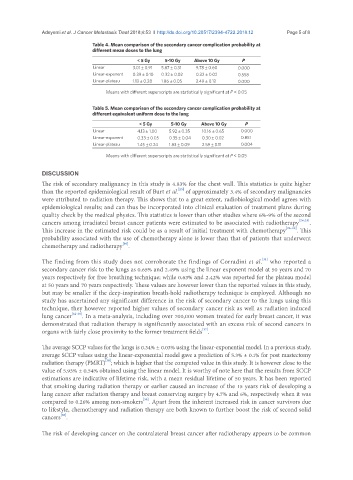Page 634 - Read Online
P. 634
Adeyemi et al. J Cancer Metastasis Treat 2018;4:53 I http://dx.doi.org/10.20517/2394-4722.2018.12 Page 5 of 8
Table 4. Mean comparison of the secondary cancer complication probability at
different mean doses to the lung
< 5 Gy 5-10 Gy Above 10 Gy P
Linear 3.01 ± 0.91 5.87 ± 0.31 9.78 ± 0.60 0.000
Linear-exponent 0.39 ± 0.10 0.32 ± 0.02 0.32 ± 0.02 0.558
Linear-plateau 1.13 ± 0.28 1.86 ± 0.05 2.49 ± 0.12 0.000
Means with different superscripts are statistically significant at P < 0.05
Table 5. Mean comparison of the secondary cancer complication probability at
different equivalent uniform dose to the lung
< 5 Gy 5-10 Gy Above 10 Gy P
Linear 4.13 ± 1.00 5.92 ± 0.35 10.16 ± 0.65 0.000
Linear-exponent 0.33 ± 0.05 0.35 ± 0.04 0.30 ± 0.02 0.851
Linear-plateau 1.45 ± 0.24 1.83 ± 0.09 2.59 ± 0.11 0.004
Means with different superscripts are statistically significant at P < 0.05
DISCUSSION
The risk of secondary malignancy in this study is 4.83% for the chest wall. This statistics is quite higher
[23]
than the reported epidemiological result of Burt et al. of approximately 3.4% of secondary malignancies
were attributed to radiation therapy. This shows that to a great extent, radiobiological model agrees with
epidemiological results; and can thus be incorporated into clinical evaluation of treatment plans during
quality check by the medical physics. This statistics is lower than other studies where 6%-9% of the second
cancers among irradiated breast cancer patients were estimated to be associated with radiotherapy [24,25] .
This increase in the estimated risk could be as a result of initial treatment with chemotherapy [26-29] . This
probability associated with the use of chemotherapy alone is lower than that of patients that underwent
[30]
chemotherapy and radiotherapy .
[31]
The finding from this study does not corroborate the findings of Corradini et al. who reported a
secondary cancer risk to the lungs as 0.65% and 2.49% using the linear exponent model at 50 years and 70
years respectively for free breathing technique; while 0.63% and 2.42% was reported for the plateau model
at 50 years and 70 years respectively. These values are however lower than the reported values in this study,
but may be smaller if the deep-inspiration breath-hold radiotherapy technique is employed. Although no
study has ascertained any significant difference in the risk of secondary cancer to the lungs using this
technique, they however reported higher values of secondary cancer risk as well as radiation induced
lung cancer [32-36] . In a meta-analysis, including over 700,000 women treated for early breast cancer, it was
demonstrated that radiation therapy is significantly associated with an excess risk of second cancers in
[37]
organs with fairly close proximity to the former treatment fields .
The average SCCP values for the lungs is 0.34% ± 0.03% using the linear-exponential model. In a previous study,
average SCCP values using the linear-exponential model gave a prediction of 5.3% ± 0.1% for post mastectomy
[38]
radiation therapy (PMRT) ; which is higher that the computed value in this study. It is however close to the
value of 5.93% ± 0.54% obtained using the linear model. It is worthy of note here that the results from SCCP
estimations are indicative of lifetime risk, with a mean residual lifetime of 50 years. It has been reported
that smoking during radiation therapy or earlier caused an increase of the 15 years risk of developing a
lung cancer after radiation therapy and breast conserving surgery by 4.7% and 6%, respectively when it was
[39]
compared to 0.26% among non-smokers . Apart from the inherent increased risk in cancer survivors due
to lifestyle, chemotherapy and radiation therapy are both known to further boost the risk of second solid
[20]
cancers .
The risk of developing cancer on the contralateral breast cancer after radiotherapy appears to be common

